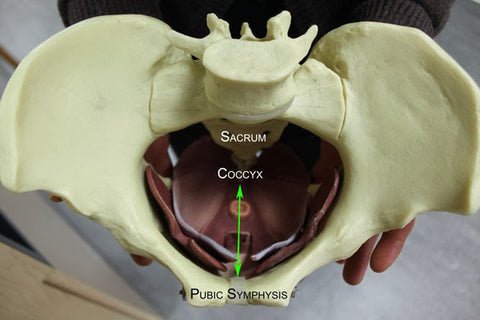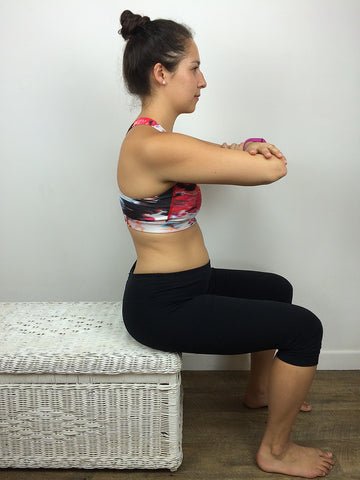What even is Pelvic Health?
with Pelvic Health Physio Sami Cattach
I keep hearing people talk about pelvic floor health. What does that mean?
Does that mean I need to do more kegel exercises or does pelvic floor health mean something else?
Pelvic floor health is an important part of women’s health and has an impact on sexual health, sexual pleasure and function. It can impact bowel and urinary function as well. In order to address the question what is pelvic floor health, we spoke to our amazing Pelvic Physiotherapist Sami Cattach to find out more.
This article explains how the muscles in the pelvic floor work and some simple steps to look after your pelvic floor.
I realise that I've been going on and on about tight and shortened pelvic floor muscles, but what does that really mean? Let me enlighten you!
Muscles have a very specific length that allows them to function optimally according to a length-tension (strength) relationship.
This demonstrates that a muscle that is too short or too long has a decreased ability to contract compared to when it is within it's optimal range.
Ever tried to do a pullup? If you start with your elbow slightly bent - where the muscle is in its mid-range - it is much easier than starting from a fully extended elbow or fully bent elbow.
A muscle that is shortened, already contracting/holding tension is actually placed at a mechanical disadvantage and therefore cannot generate as much tension (think "strength") compared to when it is relaxed. In the case of the pelvic floor muscles, a position longer than the optimal length is more akin to a situation where the muscles have been overstretched or torn - rare without having experienced some direct trauma to the area - so you don't have to worry about relaxing too far.
This is where a lot of people with pelvic floor issues spend their time - constantly contracting because we've always been led to believe that more activation = more strength which is better. Not so! In my experience, the majority of people that I treat for pelvic floor issues have muscles that are on the short side of the equation, rather than just being weak, and this can manifest in many different ways:
Stress urinary incontinence - leaking with cough/sneezing, laughing, running and jumping
Pelvic pain - tailbone, pubic bone, SIJ or lower back pain
Pain with sex
Decreased sensation or difficulty achieving orgasm with sex
Constipation
Higher risk of perineal tearing with a vaginal delivery of a baby
Pelvic Organ Prolapse
So what does this mean? Repetitive pelvic floor contractions or "Kegels" as a blanket prescription exercise may not be the solution to your pelvic floor dysfunction. Repetitively contracting already tight muscles will most likely make the situation worse and continue to bring the tailbone closer to the pubic symphysis. The smaller this distance, the shorter the muscles will be.
In most cases, we need to learn how to relax and lengthen the pelvic floor muscles first, prior to any strengthening (if needed at all) in order to restore their optimal function. Contributing factors to shortened pelvic floor muscles
Sitting for any extended period of time (more than 45min at a time or more than 4hrs a day), and especially if you sit with a slumped posture and put pressure onto your sacrum or coccyx. This constant pressure actually pushes the sacrum toward the pubic bone and shortens the distance between the ends of the muscles. Instead of turning into a floppy hammock, the muscles contract and shorten themselves (moving toward the left on the length-tension graph) to make up for the change in position.
Standing and walking with your tailbone tucked under - again this is encouraging the tailbone and sacrum to move toward the pubic bone with similar effects as above. Shortened hamstring and calf muscles wearing will also keep you in this perpetually tucked pelvic position.
Chronic constipation, breath holding or straining increased pressure directly down onto the pelvic floor muscles. The pelvic floor muscles contract and tighten in response to this pressure to stop you from pushing your organs out.
Instability and Pain in the hip, back and pelvis are often related to pelvic floor muscle dysfunction - in the presence of pain, the pelvic floor muscles may contract in an attempt to help stabilise and protect the painful joints.
Repetitive pelvic floor contractions/Kegels in an already hypertonic pelvic floor
Pain - Post surgery or post childbirth, pain in the vaginal, pelvic or abdominal area can cause tightening of the pelvic floor muscles. Particularly if there has been tearing of the muscles, they will often contract and shorten to protect themselves as they heal.
Stress - physiological and emotional stress can also contribute to hypertonic pelvic floor muscles. Some of us carry tension in our neck and shoulders, but a lot of us also hold tension in our pelvic floor muscles. Studies have shown that even just looking at images of frightening or stressful scenarios cause an automatic contraction/tightening of these muscles.
Begin improving the function of your pelvic floor muscles today:
Stop sitting on your tailbone and sacrum! Stand at work instead if you can, and if you do have to sit, try to get up an move at least once per hour.
If you are doing Kegels, ensure that you focus especially on the complete relaxation and letting go of the muscles
Learn how to relax the pelvic floor and muscles that are causing you to constantly tuck your tailbone under.
Learn how to manage your stress levels
Manage constipation, use a Squatty Potty and avoid any breath-holding or straining
See a Pelvic Health Physiotherapist for education and assessment and to see what is really happening with your pelvic floor muscles! We love to support women here at Pear.




